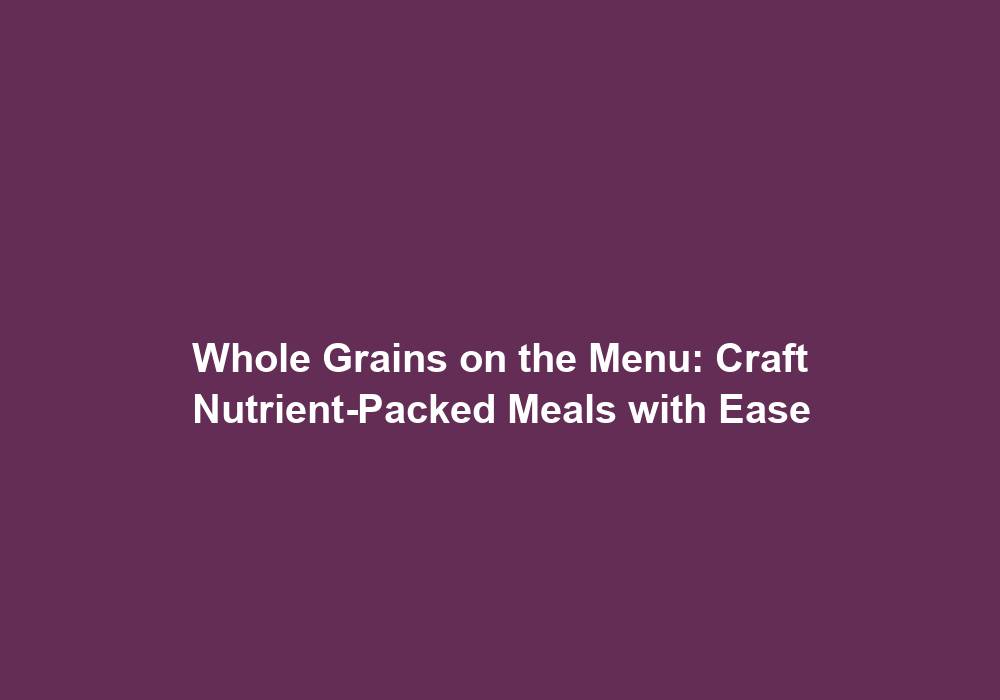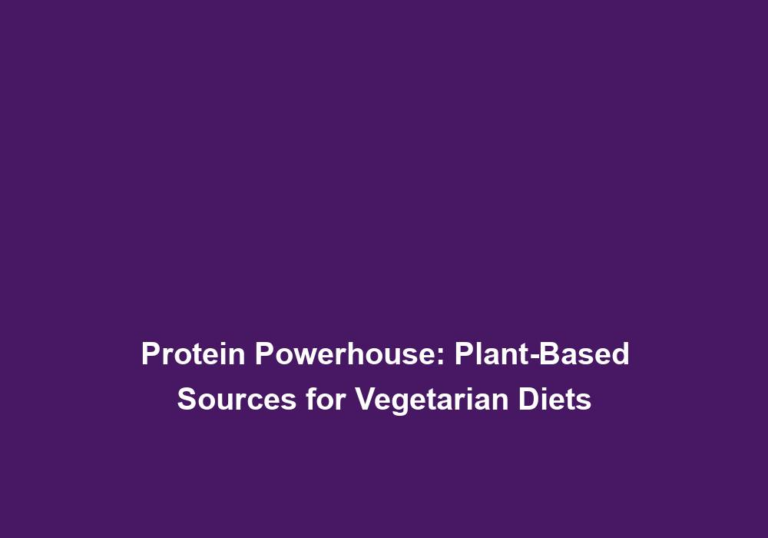Whole Grains on the Menu: Craft Nutrient-Packed Meals with Ease
In today’s health-conscious world, more and more people are recognizing the importance of including whole grains in their diets. Whole grains offer a plethora of health benefits, ranging from improved digestion to reduced risk of chronic diseases. But what exactly are whole grains, and how can we incorporate them into our meals to create nutrient-packed dishes with ease? In this article, we will delve into the world of whole grains and provide you with practical tips and delicious recipe ideas to make the most of these nutritional powerhouses.
Understanding Whole Grains
Whole grains are grains that have retained all three parts of the grain kernel – the bran, germ, and endosperm. This means they contain all the essential nutrients, including fiber, vitamins, minerals, antioxidants, and healthy fats. Consuming whole grains regularly has been linked to a reduced risk of heart disease, type 2 diabetes, stroke, and certain types of cancer. Additionally, the high fiber content of whole grains supports healthy digestion, aids weight management, and promotes a feeling of fullness, making it easier to maintain a balanced diet.
To fully understand the benefits of whole grains, it’s important to know the difference between whole grains and refined grains. Refined grains undergo processing that removes the bran and germ, stripping them of many valuable nutrients. On the other hand, whole grains retain all parts of the grain kernel, making them a more nutrient-dense choice. By choosing whole grains over refined grains, you can ensure that you’re getting the maximum nutritional value from your food.
Exploring Different Types of Whole Grains
Whole grains come in various shapes, sizes, and flavors, offering a wide range of culinary possibilities. Here are some popular types of whole grains you can incorporate into your meals:
-
Quinoa: Known as a complete protein, quinoa is a versatile grain that is gluten-free and packed with essential amino acids. It is also high in fiber and contains a variety of vitamins and minerals, such as magnesium, phosphorus, and folate. Quinoa can be used as a base for salads, added to soups and stews, or enjoyed as a side dish.
-
Brown Rice: A staple in many cuisines, brown rice is a nutritious alternative to white rice, as it retains the bran and germ layers. It is a good source of fiber, minerals, and antioxidants. Brown rice can be used in a variety of dishes, including stir-fries, pilafs, and grain bowls.
-
Oats: Whether in the form of steel-cut oats, rolled oats, or oat flour, oats are a fantastic source of soluble fiber and can be used in a variety of dishes. They provide a creamy texture and nutty flavor to breakfast porridge, baked goods, and even savory recipes like meatloaf or veggie burgers.
-
Barley: Barley’s chewy texture and nutty flavor make it an excellent addition to soups, stews, and salads. It is also rich in fiber and provides important vitamins and minerals, including manganese, selenium, and niacin. Barley can be used as a base for grain salads or as a hearty addition to casseroles and risottos.
-
Buckwheat: Despite its name, buckwheat is not related to wheat and is naturally gluten-free. It is often used to make soba noodles or as a flour alternative in gluten-free recipes. Buckwheat is a good source of fiber and contains nutrients like magnesium, copper, and iron. It has a slightly nutty flavor and can be used in pancakes, crepes, or as a side dish.
-
Millet: Millet is a small grain that is gluten-free and packed with minerals such as magnesium and phosphorus. It has a mild, slightly sweet flavor and a fluffy texture. Millet can be used in various dishes, including pilafs, salads, and breakfast bowls. It can also be ground into flour and used in baking.
-
Whole Wheat: Whole wheat is a popular choice for bread, pasta, and baked goods. It offers a higher fiber content compared to refined wheat products. Whole wheat is rich in nutrients like vitamin E, B vitamins, iron, and selenium. It can be used in a variety of recipes, from homemade bread to whole wheat pasta dishes.
By incorporating different types of whole grains into your diet, you can enjoy a variety of flavors and textures while reaping the nutritional benefits. Experiment with these grains and discover new favorite recipes that will nourish your body and delight your taste buds.
Tips for Incorporating Whole Grains into Your Meals
Now that we have explored different types of whole grains, let’s dive into some practical tips to seamlessly incorporate them into your meals:
1. Start Your Day with Whole Grains
Kickstart your mornings with a nourishing whole grain breakfast. Replace refined cereals with rolled oats topped with fresh fruits, nuts, and a drizzle of honey. Oats can also be used to make overnight oats or granola. Alternatively, experiment with quinoa porridge or whole grain toast spread with avocado or nut butter. These breakfast options will provide sustained energy throughout the morning and keep you feeling satisfied until lunchtime.
2. Substitute Refined Grains with Whole Grains
When cooking your favorite dishes, such as stir-fries, pilafs, or casseroles, swap refined grains like white rice or pasta with their whole grain counterparts. This simple switch will enhance the nutritional value of your meals without compromising on taste or texture. For example, use brown rice instead of white rice in a stir-fry or whole wheat pasta in a pasta dish. You can also try using quinoa or barley as a base for grain bowls or as a side dish.
3. Get Creative with Whole Grain Salads
Whole grains make a fantastic base for salads, adding texture, flavor, and nutritional value. Combine cooked quinoa or barley with fresh vegetables, herbs, and a tangy dressing for a satisfying and wholesome salad. You can also add other ingredients like roasted vegetables, grilled chicken, or feta cheese to enhance the flavors. Experiment with different combinations to keep your salads interesting and packed with nutrients. Whole grain salads can be enjoyed as a main course or as a side dish.
4. Bake with Whole Grain Flours
Revamp your baking recipes by using whole grain flours instead of refined white flour. Whole wheat flour, oat flour, and buckwheat flour all work well in various baked goods, adding a hearty and nutty flavor. Start by substituting a portion of the white flour in your recipes and gradually increase the amount until you achieve your desired texture and taste. For example, use a combination of whole wheat flour and all-purpose flour in bread or muffin recipes. You can also experiment with using oat flour or buckwheat flour in pancakes, cookies, or cakes. These whole grain flours will not only provide added nutrients but also enhance the overall flavor and texture of your baked goods.
By following these tips, you can easily incorporate whole grains into your meals and enjoy their numerous health benefits. Whether you’re starting your day with a wholesome breakfast, replacing refined grains with whole grains, getting creative with whole grain salads, or baking with whole grain flours, there are endless possibilities to explore. Now, let’s take a look at some delicious and nutrient-packed whole grain recipes to inspire you in the kitchen.
Nutrient-Packed Whole Grain Recipes
To inspire you to get creative in the kitchen, here are a few delicious and nutrient-packed whole grain recipes:
1. Quinoa Stuffed Bell Peppers
Ingredients:
- 4 bell peppers (any color)
- 1 cup cooked quinoa
- 1 can black beans, drained and rinsed
- 1 cup corn kernels
- 1 small onion, diced
- 2 cloves garlic, minced
- 1 teaspoon cumin
- 1 teaspoon paprika
- Salt and pepper to taste
- Shredded cheese (optional)
Instructions:
- Preheat the oven to 375°F (190°C).
- Cut off the tops of the bell peppers and remove the seeds and membranes.
- In a large mixing bowl, combine cooked quinoa, black beans, corn, onion, garlic, cumin, paprika, salt, and pepper.
- Stuff the bell peppers with the quinoa mixture and place them in a baking dish.
- If desired, sprinkle shredded cheese over the stuffed bell peppers.
- Bake for 25-30 minutes, or until the bell peppers are tender and the filling is heated through.
- Serve hot and enjoy this nutritious meal!
2. Mediterranean Barley Salad
Ingredients:
- 1 cup cooked barley
- 1 cup cherry tomatoes, halved
- 1 cucumber, diced
- 1/2 cup Kalamata olives, pitted and halved
- 1/4 cup red onion, thinly sliced
- 1/4 cup feta cheese, crumbled
- 2 tablespoons extra virgin olive oil
- 1 tablespoon lemon juice
- 1 teaspoon dried oregano
- Salt and pepper to taste
Instructions:
- In a large mixing bowl, combine cooked barley, cherry tomatoes, cucumber, Kalamata olives, red onion, and feta cheese.
- In a separate small bowl, whisk together extra virgin olive oil, lemon juice, dried oregano, salt, and pepper.
- Drizzle the dressing over the barley salad and toss gently to combine.
- Refrigerate for at least 30 minutes to allow the flavors to meld together.
- Serve chilled and enjoy the refreshing Mediterranean flavors!
By incorporating these simple tips and trying out these delicious recipes, you can elevate your meals to a whole new level of nutrition and flavor. Whole grains are not only versatile but also readily available, making it easier than ever to craft nutrient-packed meals with ease. So, go ahead and explore the world of whole grains, and let your culinary creativity shine!







